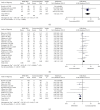Comparison of Effectiveness and Safety between High-Power Short-Duration Ablation and Conventional Ablation for Atrial Fibrillation: A Systematic Review and Meta-Analysis
- PMID: 36072362
- PMCID: PMC9398879
- DOI: 10.1155/2022/6013474
Comparison of Effectiveness and Safety between High-Power Short-Duration Ablation and Conventional Ablation for Atrial Fibrillation: A Systematic Review and Meta-Analysis
Abstract
Aim: We aimed to evaluate the effectiveness and safety between high-power short-duration (HPSD) radiofrequency ablation (RFA) and conventional RFA in patients with atrial fibrillation (AF).
Methods: Studies comparing HPSD and traditional applications in patients undergoing initial catheter ablation for atrial fibrillation from inception through December 2021 were searched on Pubmed, Medline, Cochrane, and Clinicaltrials.gov.
Results: The meta-analysis included seventeen studies with a total of 4934 patients. HPSD group decreased procedure duration (mean difference (MD) -38.28 min, P < 0.001), RF duration (MD -20.51 min, P < 0.001), fluoroscopy duration (MD -5.19 min, P < 0.001), and acute pulmonary vein reconnection (Odds ratio (OR) 0.40, P < 0.001), while improving the freedom from atrial arrhythmia at one year (OR 1.48, 95% confidence interval (CI) 1.12-1.94, P=0.005) and rates of first-pass isolation (OR 8.92, P=0.001). Compared with the conventional group, freedom from atrial arrhythmia at one-year follow-up was higher in the HPSD group without the guidance of AI/LSI (OR 1.66, P=0.01) and studies with a power setting of 40-50 W (OR 1.93, P=0.002). Nevertheless, the two groups had similar effectiveness with a power setting of 50 W in the HPSD RFA (OR 1.10, P=0.52). There was no difference in complications between the two groups (P=0.71).
Conclusion: HPSD RFA was associated with shorter procedure duration, higher freedom from atrial arrhythmia, and comparable safety compared to conventional RFA.
Copyright © 2022 Shuyu Jin et al.
Conflict of interest statement
The authors declare that the research was conducted in the absence of any commercial or financial relationships that could be construed as potential conflicts of interest.
Figures




Similar articles
-
Network meta-analysis and systematic review comparing efficacy and safety between very high power short duration, high power short duration, and conventional radiofrequency ablation of atrial fibrillation.J Cardiovasc Electrophysiol. 2023 Apr;34(4):869-879. doi: 10.1111/jce.15831. Epub 2023 Jan 29. J Cardiovasc Electrophysiol. 2023. PMID: 36691892
-
High-Power Short-Duration Ablation Versus Conventional Power Ablation in Pulmonary Vein Isolation in Patients With Atrial Fibrillation: An Updated Systematic Review and Meta-Analysis of Randomized Controlled Trials.J Cardiovasc Electrophysiol. 2025 Aug 31. doi: 10.1111/jce.16735. Online ahead of print. J Cardiovasc Electrophysiol. 2025. PMID: 40886137 Review.
-
Cryoablation versus hybrid radiofrequency with high- and very-high-power short-duration catheter ablation for the treatment of paroxysmal atrial fibrillation.Hellenic J Cardiol. 2025 Jul-Aug;84:75-80. doi: 10.1016/j.hjc.2024.03.014. Epub 2024 Mar 28. Hellenic J Cardiol. 2025. PMID: 38554832
-
Efficacy and Safety of Pulsed-Field Versus High-Power Short-Duration Ablation for Atrial Fibrillation: A Systematic Review and Meta-Analysis With Reconstructed Time-to-Event Data.J Cardiovasc Electrophysiol. 2025 Aug;36(8):1762-1784. doi: 10.1111/jce.16728. Epub 2025 May 28. J Cardiovasc Electrophysiol. 2025. PMID: 40433752 Free PMC article.
-
Comparison of very high-power short-duration, high-power short-duration, and low-power long-duration radiofrequency ablation for atrial fibrillation: A systematic review and network meta-analysis.Pacing Clin Electrophysiol. 2023 Dec;46(12):1609-1634. doi: 10.1111/pace.14879. Epub 2023 Nov 16. Pacing Clin Electrophysiol. 2023. PMID: 37971718
Cited by
-
Comparative Analysis of Clinical Outcomes of High-power, Short-duration Ablation versus Low-power, Long-duration Ablation Strategy in Patients with Atrial Fibrillation: A Comprehensive Umbrella Review of Meta-analyses.J Innov Card Rhythm Manag. 2024 Aug 15;15(8):5963-5980. doi: 10.19102/icrm.2024.15083. eCollection 2024 Aug. J Innov Card Rhythm Manag. 2024. PMID: 39193534 Free PMC article. Review.
-
High-Power Short-Duration Ablation of Paroxysmal and Persistent Atrial Fibrillation.Rev Cardiovasc Med. 2023 Dec 25;24(12):363. doi: 10.31083/j.rcm2412363. eCollection 2023 Dec. Rev Cardiovasc Med. 2023. PMID: 39077093 Free PMC article. Review.
-
Comparison of high-power single-ring isolation and box isolation in elderly patients with persistent atrial fibrillation.BMC Geriatr. 2025 May 16;25(1):344. doi: 10.1186/s12877-025-05981-y. BMC Geriatr. 2025. PMID: 40380084 Free PMC article.
-
Proactive esophageal cooling during radiofrequency cardiac ablation: data update including applications in very high-power short duration ablation.Expert Rev Med Devices. 2025 Jan;22(1):63-73. doi: 10.1080/17434440.2024.2447809. Epub 2025 Jan 1. Expert Rev Med Devices. 2025. PMID: 39720904 Review.
References
-
- Shah S., Barakat A. F., Saliba W. I., et al. Recurrent atrial fibrillation after initial long-term ablation success: electrophysiological findings and outcomes of repeat ablation procedures. Circulation: Arrhythmia and Electrophysiology . 2018;11(4) doi: 10.1161/circep.117.005785.e005785 - DOI - PubMed
Publication types
MeSH terms
LinkOut - more resources
Full Text Sources
Medical
